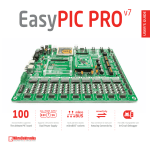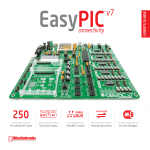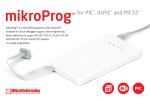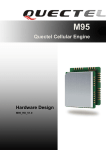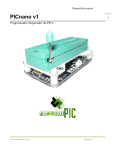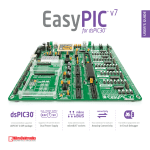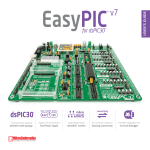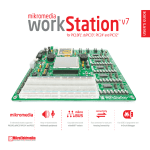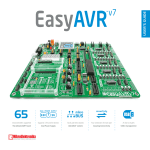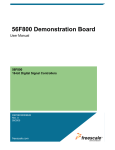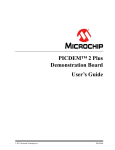Download User's guide
Transcript
User's guide EasyPIC PRO™ v7 is a full-featured development board for high pin count 8-bit PIC® microcon trollers. It contains many on-board modules neccessary for development of variety of applications, including graphics, Ethernet, USB, Temperature measurement and other. On-board mikroProg™ programmer and debugger supports nearly 100 PIC® microcontrollers. EasyPIC PRO v7 To our valued customers From the day one, we in mikroElektronika gave ourselves the highest possible goals in pursuit of excellence. That same day, the idea of EasyPIC™ development board was born. And we all grew together with EasyPIC™. In its each and tiniest piece we had put all of our energy, creativity and sense of what’s best for an engineer. I’ve personally assembled hundreds of early EasyPIC™ boards myself with my home soldering iron. EasyPIC PRO™ follows the same path. With the new 7th generation of high pin count PIC® boards it emerged as a unified and clear concept, supporting both 5V and 3.3V microcontrollers. Now we proudly say that it's one of a kind in the world - good looking, powerful and easy to use. You made the right choice. But the fun has only just begun! Nebojsa Matic, Owner and General Manager of mikroElektronika Table of contents Introduction Communication Introduction . . . . . . . . . . . . . . . . . . . . . . . . . . . . . . . . . . . . . . . 04 UART via RS-232 . . . . . . . . . . . . . . . . . . . . . . . . . . . . . . . . . 22 It's good to know . . . . . . . . . . . . . . . . . . . . . . . . . . . . . . . . . . 05 UART via USB . . . . . . . . . . . . . . . . . . . . . . . . . . . . . . . . . . . . . 23 USB device communication . . . . . . . . . . . . . . . . . . . . . . . . 24 Ethernet communication . . . . . . . . . . . . . . . . . . . . . . . . . . 25 Power Supply Dual power supply . . . . . . . . . . . . . . . . . . . . . . . . . . . . . . . . 06 Displays Default MCU card Supported microcontrollers . . . . . . . . . . . . . . . . . . . . . . . . 08 Programmer/debugger LCD 2x16 characters . . . . . . . . . . . . . . . . . . . . . . . . . . . . . . 26 GLCD 128x64px . . . . . . . . . . . . . . . . . . . . . . . . . . . . . . . . . . 27 Touchpanel controller . . . . . . . . . . . . . . . . . . . . . . . . . . . . . 28 On-board programmer . . . . . . . . . . . . . . . . . . . . . . . . . . . . . 12 Other modules Installing programmer drivers . . . . . . . . . . . . . . . . . . . . . . 14 Piezo Buzzer . . . . . . . . . . . . . . . . . . . . . . . . . . . . . . . . . . . . . . 29 Programming software . . . . . . . . . . . . . . . . . . . . . . . . . . . . 15 DS1820 - Digital Temperature Sensor . . . . . . . . . . . . . . 30 mikroICD™ - In Circuit Debugger . . . . . . . . . . . . . . . . . . . 16 LM35 - Analog Temperature Sensor . . . . . . . . . . . . . . . . 31 ADC inputs . . . . . . . . . . . . . . . . . . . . . . . . . . . . . . . . . . . . . . . . 32 I2C EEPROM . . . . . . . . . . . . . . . . . . . . . . . . . . . . . . . . . . . . . . . 33 Connectivity Input/Output Group . . . . . . . . . . . . . . . . . . . . . . . . . . . . . . . 18 Output voltages . . . . . . . . . . . . . . . . . . . . . . . . . . . . . . . . . . . 34 mikroBUS™ sockets . . . . . . . . . . . . . . . . . . . . . . . . . . . . . . . 20 Additional GNDs . . . . . . . . . . . . . . . . . . . . . . . . . . . . . . . . . . . 35 Click Boards™ are plug and play . . . . . . . . . . . . . . . . . . . . 21 What’s Next? . . . . . . . . . . . . . . . . . . . . . . . . . . . . . . . . . . . . . . 36 page 3 introruction Introduction For the first time in history we have managed to combine all the features of BIGPIC6 and LV18F v6 boards, which supported high pin count PICs into the unique EasyPIC™ PRO v7. Supporting microcontrollers in both 5V and 3.3V power supply technology, this board is truly fantastic tool for development. We have put a lot of effort into board design, making it easy to use, and we have placed lots of modules that will help you in your work. Newly redesigned MCU sockets are here to stay. They are well organized and cover all high-pin-count PIC® microcontrollers in TQFP packaging. We carefully picked high-quality components and chose a 2.54mm PCB, which makes this board especially durable. We hope you will enjoy it as much as we do. EasyPIC PRO™ v7 Development Team Two Connectors for each port 3.3V and 5V power supply Amazing connectivity Everything is already here ™ For easier connections ™ mikroProg on board Multimedia peripherals mikroBUS support EasyPIC PRO™ v7 is all about connectivity. Having two different connectors for each port, you can connect accessory boards, sensors and your custom electronics easier then ever before. Powerful on-board mikroProg™ programmer and In-Circuit debugger can program and debug nearly 100 microcontrollers. You will need it, whether you are a professional or a beginner. EasyPIC PRO™ v7 is among few development boards which support both 3.3V and 5V microcontrollers. This feature greatly increases the number of supported MCUs.It’s like having two boards instead of one! Just plug in your mikroBUS™ board, and it’s ready to work. We picked up a set of the most useful pins you need for development and made a pinout standard you will enjoy using. EasyPIC PRO v7 page 4 introduction It's good to know PIC18F87K22 is the default microcontoller! PIC18F87K22 is the default chip of EasyPIC PRO™ v7. Featuring nanoWatt XLP technology, it has 16 MIPS ™ System Specification - Great choice for both beginners and operation, 128K bytes of linear program memory, - Rich with modules 3896 bytes of linear data memory, and support for - Comes with examples for mikroC, a wide range of power supply from 1.8V to 5V. It’s power supply 7–23V AC or 9–32V DC or via USB cable (5V DC) professionals power consumption mikroBasic and mikroPascal compilers ~90mA at 5V when all peripheral modules are disconnected loaded with great modules: 69 General purpose I/O pins, 24 Analog Input pins (AD), internal Real time board dimensions 266 x 220mm (10.47 x 8.66 inch) clock and calendar (RTCC), support for Capacitive Touch Sensing using Charge Time Measurement Unit (CTMU), six 8-bit timers and five 16-bit timers. It weight 475g (1.0472 lbs) also has ten CCP modules, three Comparators and two MSSP modules which can be either SPI or I2C. Package contains 19122011 www.mikroe.com Copyright ©2011 Mikroelektronika. All rights reserved. Mikroelektronika, Mikroelektronika logo and other Mikroelektronika trademarks are the property of Mikroelektronika. All other tradmarks are the property of their respective owners. Unauthorised copying, hiring, renting, public performance and broadcasting of this DVD prohibited. 1 2 Damage resistant protective box EasyPIC PRO EasyPIC PRO™ v7 board in antistatic bag 3 USB cable 4 User Manuals and Board schematics 5 DVD with examples and documentation v7 page 5 power supply Power supply Board contains switching power supply that creates stable voltage and current levels necessary for powering each part of the board. Power supply section contains two power regulators: MC34063A, which generates VCC-5V, and MC33269DT3.3 which creates VCC-3.3V power supply, thus making the board capable of supporting both 5V and 3.3V microcontrollers. Power supply unit can be powered in two different ways: with USB power supply, and using external adapters via adapter connector (CN19) or additional screw terminals (CN18). External adapter voltage levels must be in range of 9-32V DC and 7-23V AC. Use jumper J2 to specify which power source you are using, and jumper J1 to specify whether you are using 5V or 3.3V microcontroller. Upon providing the power using either external adapter, or USB power source, you can turn the board on using SWITCH 1 (Figure 3-1). Figure 3-1: Dual power supply unit of EasyPIC PRO™ v7 Figure 3-2: Dual power supply unit schematics EasyPIC PRO v7 page 6 power supply Smart engineering of EasyPIC PRO™ v7 develop ment board allowed us to support both 3.3V and 5V microcontrollers on a single board, which is almost 100 high pin count PIC® devices. Power supply: via DC connector or screw terminals (7V to 23V AC or 9V to 32V DC), or via USB cable (5V DC) Power consumption: up to 600mA (depending on how many on-board modules are currently active) How to power the board? 1. With USB cable 1 2 3 4 5 6 Set J2 jumper to USB position To power the board with USB cable, place jumper J2 in USB position, and place jumper J1 in 5V or 3.3V position, depending on which microcontroller you are using. You can then plug in the USB cable as shown on images 1 and 2 , and turn the power switch ON. 2. Using adapter Set J2 jumper to EXT position To power the board via adapter connector, place jumper J2 in EXT position, and place jumper J1 in 5V or 3.3V position, depending on which microcontroller you are using. You can then plug in the adapter cable as shown on images 3 and 4 , and turn the power switch ON. 3. With laboratory power supply Set J2 jumper to EXT position To power the board using screw terminals, place jumper J2 in EXT position, and place jumper J1 in 5V or 3.3V position, depending on which microcontroller you are using. You can then plug in the adapter cable as shown on images 5 and 6 , and turn the power switch ON. EasyPIC PRO v7 page 7 supported MCUs Default MCU card Microcontrollers are supported using specialized MCU cards containing 104 pins, which are placed into the on-board female MCU socket. Currently, there are three types of cards: Standard 80-pin TQFP, Ethernet 80-pin TQFP card and Ethernet 100-pin TQFP PF card. Standard card supports 80-pin PIC18Fxxxx, PIC18FxxJxx and PIC18FxxKxx microcontrollers, with or without USB support. It contains several SMD jumpers, which are supposed to be placed or removed, depending on the microcontroller. Default MCU card that comes with the EasyPIC PRO™ v7 package is shown on Figure 4-1. It contains PIC18F87K22 microcontroller which is loaded with on-chip modules and is a great choice for both beginners and professionals. After testing and building the final program, this card can also be taken out of the board socket and used in your final device. 1 PIC18F87K22 microcontroller. Featuring nanoWatt XLP™ technology, it has 16 MIPS operation, 128K bytes of linear program memory, 3896 bytes of linear data memory, and support for a wide range of power supply from 1.8V to 5V. 2 16MHz crystal oscillator. We carefully chose the most convenient crystal value that provides clock frequency which can be used directly, or with the PLL multipliers and dividers to create higher MCU clock value. 3 VCAP jumper. Some PIC18FK and all PIC18FJ microcontrollers have cores that work on 1.8V-2.5V voltage range, and peripherals that work with 3.3V and 5V voltages. Internally, those microcontrollers have power regulators which adjust the core voltage levels. In order for those devices to have a stable operation of the core, manufacturer recommends that decoupling capacitive filters should be provided, and connected between specific microcontroller pins designated with VCAP and GND. This MCU card provides a VCAP jumper which is used for this purpose. Jumper is removed by default. 4 USB communication lines. These two jumpers, when in USB position, connect D+ and D- lines of the on-board USB connector with RF3 and RF4 microcontroller pins. Since PIC18F87K22 doesn't support USB, jumpers are in I/O position. 5 VUSB line jumper. For PIC18F8xJ5x devices, this jumper should be connected to VCC for enabling internal USB controller. Since PIC18F87K22 doesn't support USB, this jumper is in I/O position. 6 ENVREG selection jumper. PIC18FJ and PIC18FK microcontrollers are using internal voltage regulator which is enabled by placing this jumper in VCC position. 2 6 1 5 3 4 Figure 4-1: Default MCU card with PIC18F87K22 EasyPIC PRO v7 page 8 supported MCUs VCC RJ3 RB1 RB3 RB5 RB7 RC4 RC2 RJ6 VCC HD4D 103 101 99 97 95 93 91 89 87 85 83 81 79 GND 104 102 100 98 96 94 92 90 88 86 84 82 GND 80 RJ2 RB0 RB2 RB4 RB6 RC5 RC3 RJ7 VCC VCC E2 10uF VCC 80 79 78 77 76 75 74 73 72 71 70 69 68 67 66 65 64 63 62 61 RD1 RD2 RD3 RD4 RD5 RD6 RD7 RJ0 RJ1 RH1 RH0 RE2 RE3 RE4 RE5 RE6 RE7 RD0 E1 10uF RH1 RH0 RE2 RE3 RE4 RE5 RE6 RE7 RD0 VDD GND RD1 RD2 RD3 RD4 RD5 RD6 RD7 RJ0 RJ1 U1 GND VCC J1B E3 10uF HD1A J3 VCC RF4 RF4/DP DP RF3 RF3/DM DM J4 VCC RF1 RF1/USB VCC RF0 ENR/RF0 RJ2 RJ3 RB0 RB1 RB2 RB3 RB4 RB5 RB6 C1 OSC2 OSC1 GND RJ4 RC6 RC1 RA5 22pF RA1 RA3 X1 16MHz RB7 RC5 RC4 RC3 RC2 RJ7 RJ6 C2 RF1 RH5 GND 22pF 78 76 74 72 70 68 66 64 62 60 58 56 54 77 75 73 71 69 67 65 63 61 59 57 55 53 VCC RJ5 RC7 RC0 RA4 RA0 RA2 RF0 RH4 VCC HD3C VCC VCC C3 100nF VCC C4 100nF VCC C5 100nF E6 10uF VCC J5 E5 10uF RF7 RF5 RF3 RH7 DP VCC VCC RH3 RE0 RG1 RG3 RG4 27 29 31 33 35 37 39 41 43 45 47 49 51 HD2B 28 GND 30 RH2 32 RE1 34 RG0 36 RG2 38 MCLR# 40 42 RF6 44 RF4 46 RF2 48 RH6 50 DM 52 GND E4 10uF PIC18F87K22 80pin TQFP 60 59 58 57 56 55 54 53 52 51 50 49 48 47 46 45 44 43 42 41 21 22 23 24 25 26 27 28 29 30 31 32 33 34 35 36 37 38 39 40 J2 VCAP RF7 RF6 RF5 RF4/DP RF3/DM RF2 RH7 RH6 RJ2 RJ3 RB0 RB1 RB2 RB3 RB4 RB5 PGC/RB6 GND OSC2/RA6 OSC1/RA7 VDD PGD/RB7 RC5 RC4 RC3 RC2 RJ7 RJ6 RA5 RA4 RC1 RC0 RC6 RC7 RJ4 RJ5 RJ0 RD6 RD4 RD2 RD0 RE6 RE4 RE2 RH1 GND RA3 RA2 RA1 RA0 2 4 6 8 10 12 14 16 18 20 22 24 26 RH2 RH3 RE1 RE0 RG0 RG1 RG2 RG3 MCLR RG4 GND VCCcore/Vcap/VDD RF7 RF6 RF5 RF4/D+ RF3/DRF2 RH7 RH6 RH5 RH4 RF1/VUSB ENVREG/RF0 AVCC AGND RA3 RA2 RA1 RA0 GND VDD RA5 RA4 RC1 RC0 RC6 RC7 RJ4 RJ5 RJ1 RD7 RD5 RD3 RD1 RE7 RE5 RE3 RH0 VCC 1 3 5 7 9 11 13 15 17 19 21 23 25 1 2 3 4 5 6 7 8 9 10 11 12 13 14 15 16 17 18 19 20 RH5 RH4 RF1/USB ENR/RF0 VCC RH2 RH3 RE1 RE0 RG0 RG1 RG2 RG3 MCLR# RG4 Figure 4-2: Default MCU card schematics EasyPIC PRO v7 page 9 supported MCUs How to properly place your MCU card into the socket? Before you plug the microcontroller card into the socket, make sure that the power supply is turned off. Images below show how to correctly plug the card. First make sure that MCU card orientation matches the silkscreen outline on the 1 Figure 4-3: On-board MCU socket has silksreen markings which will help you to correctly orient the MCU card before inserting. EasyPIC PRO™ v7 board MCU socket. Place the MCU card over the socket, so each male header encloses the right angle with the female socket, as shown in Figure 4-4. Then put the MCU card slowly down until all the pins match the socket. Check again if 2 Figure 4-4: Place the MCU card on the socket so the pins are aligned correctly. everything is placed correctly and press the MCU card until it is completely plugged into the socket as shown in Figure 4-5. If done correctly, all pins should be fully inserted. Only now you can turn on the power supply. 3 Figure 4-5 Properly placed MCU card will have equally leveled pins. EasyPIC PRO v7 page 10 supported MCUs Other supported MCU cards mikroElektronika currently offers total of five populated MCU cards with different microcontrollers. You can also purchase empty PCB cards that you can populate on your own and solder any supported microcontroller you need in your development. This way your EasyPIC PRO™ v7 board becomes truly flexible and reliable tool for almost any of your PIC® projects. MCU cards can also be used in your final devices. For complete list of currently available MCU cards, please visit the board webpage: http://www.mikroe.com/eng/products/view/815/easypic-pro-v7-development-system/ List of other available populated MCU cards Besides default MCU card that comes with EasyPIC PRO™ v7, mikroElektronika offers three other standard 80-pin TQFP cards with PIC18F87J50, PIC18F8520 and PIC18F8722 microcontrollers. Additional 80-pin TQFP Ethernet card with PIC18F87J60 enables you to utilize the ethernet connector and build ethernet applications easily. 1 Figure 4-2: Standard 80-pin MCU card with PIC18F87J50, which supports USB. EasyPIC PRO 2 Figure 4-3: Standard 80-pin MCU card with PIC18F8520. 3 Figure 4-4: Standard 80-pin MCU card with PIC18F8722. with Ethernet! support 4 Figure 4-5: Ethernet 80-pin MCU card with PIC18F87J60 microcontroller with internal ethernet module. v7 page 11 programming On-board programmer What is mikroProg™? mikroProg™ is a fast USB 2.0 programmer with mikroICD™ hardware In-Circuit Debugger. Smart engineering allows mikroProg™ to support all nearly 100 PIC18 devices in a single programmer. It also features a powerful mikroICD™ debugger which will be of great help in your development. Outstanding performance and easy operation are among it's top features. Why so many LEDs? DATA BUS Figure 5-1: mikroProg™ block schematics Three LEDs indicate specific programmer operation. Link LED lights up when USB link is established with your PC, Active LED lights up when programmer is active. Data is on when data is being transfered between the programmer and PC software (compiler or mikroProg Suite™ for PIC®). How do I start? In order to start using mikroProg™, and program your microcontroller, you just have to follow two simple steps: 1. Install the necessary software - Install USB drivers - Install mikroProg Suite™ for PIC® software 2. Power up the board, and you are ready to go. - Plug in the programmer USB cable - LINK LED should light up. EasyPIC PRO v7 page 12 Here's the list of all microcontrollers which are supported with mikroProg™ programmer and debugger on EasyPIC PRO™ v7 board. The list may grow with each new release of mikroProg Suite™ for PIC® software. PIC18F83J90 PIC18F87J93 PIC18F8527 PIC18F8490 PIC18F65J15 PIC18F44J11 PIC18F84J90 PIC18F86J50 PIC18F6620 PIC18F8520 PIC18F66J10 PIC18F45J11 PIC18F85J90 PIC18F86J55 PIC18F6720 PIC18F8620 PIC18F66J15 PIC18F46J11 PIC18F83J11 PIC18F87J50 PIC18F6310 PIC18F8720 PIC18F67J10 PIC18F44J50 PIC18F84J11 PIC18F85J50 PIC18F6410 PIC18F8393 PIC18F66J11 PIC18F45J50 PIC18F85J11 PIC18F86J60 PIC18F6390 PIC18F8493 PIC18F66J16 PIC18F46J50 PIC18F85J10 PIC18F86J65 PIC18F6490 PIC18F63J90 PIC18F67J11 PIC18F67J60 PIC18F85J15 PIC18F87J60 PIC18F6585 PIC18F64J90 PIC18F65J50 PIC18LF43K22 PIC18F86J10 PIC18F96J60 PIC18F6680 PIC18F65J90 PIC18F66J55 PIC18F46K22 PIC18F86J15 PIC18F96J65 PIC18F8310 PIC18F63J11 PIC18F67J50 PIC18F45K22 PIC18F87J10 PIC18F97J60 PIC18F8410 PIC18F64J11 PIC18F43K20 PIC18F44K22 PIC18F86J11 PIC18F85K22 PIC18F8585 PIC18F65J11 PIC18F44K20 PIC18F43K22 PIC18F86J16 PIC18F86K22 PIC18F8680 PIC18F66J90 PIC18F45K20 PIC18F66J60 PIC18F87J11 PIC18F87K22 PIC18F8622 PIC18F67J90 PIC18F46K20 PIC18F66J65 PIC18F86J90 PIC18F85K90 PIC18F8627 PIC18F66J93 PIC18LF46K22 PIC18F87J90 PIC18F86K90 PIC18F8722 PIC18F67J93 PIC18LF45K22 PIC18F86J93 PIC18F87K90 PIC18F8390 PIC18F65J10 PIC18LF44K22 Programming with ICD2/ICD3 EasyPIC PRO™ v7 is equipped with RJ-12 connector compatibile with Microchip® ICD2® and ICD3® external programmers. This way you can override the on-board mikroProg™ programmer and In-Circuit Debugger, and use other programming tools with the board. Insert your ICD programmer cable into connector CN8, as shown in images 1 and 2 . EasyPIC PRO 1 2 v7 page 13 programming List of microcontrollers supported with mikroProg™ On-board mikroProg™ requires drivers in order to work. Drivers are located on the Product DVD that you received with the EasyPIC PRO™ v7 package: DVD://download/eng/software/ development-tools/universal/ mikroprog/mikroprog_for_pic_ drivers_v200.zip 19122011 www.mikroe.com Av ai Copyright ©2011 Mikroelektronika. All rights reserved. Mikroelektronika, Mikroelektronika logo and other Mikroelektronika trademarks are the property of Mikroelektronika. All other tradmarks are the property of their respective owners. Unauthorised copying, hiring, renting, public performance and broadcasting of this DVD prohibited. lab le on Product D! programming Installing programmer drivers DV When you locate the drivers, please extract files from the ZIP archive. Folder with extracted files contains folders with drivers for different operating systems. Depending on which operating system you use, choose adequate folder and open it. In the opened folder you should be able to locate the driver setup file. Double click on setup file to begin installation of the programmer drivers. Step 1 - Start Installation Step 2 - Accept EULA Welcome screen of the installation. Just click on Next button to procede. Carefully read End User License Agreement. If you agree with it, click Next to procede. Step 3 - Installing drivers Drivers are installed automatically in a matter of seconds. Step 4 - Finish installation You will be informed if the dirvers are installed correctly. Click on Finish button to end installation process. EasyPIC PRO v7 page 14 mikroProg Suite™ for PIC® On-board mikroProg™ programmer requires special programming software called mikroProg Suite™ for PIC®. This software is used for programming all of Microchip® microcontroller families, including PIC10, PIC12, PIC16, PIC18, dsPIC30/33, PIC24 and PIC32. Software has intuitive interface and SingleClick™ programming technology. To begin, first locate the installation archive on the Product DVD: 19122011 www.mikroe.com Copyright ©2011 Mikroelektronika. All rights reserved. Mikroelektronika, Mikroelektronika logo and other Mikroelektronika trademarks are the property of Mikroelektronika. All other tradmarks are the property of their respective owners. Unauthorised copying, hiring, renting, public performance and broadcasting of this DVD prohibited. lab le on Produc Installation wizard - 6 simple steps DVD://download/eng/software/development-tools/universal/ mikroprog/mikroprog_suite_for_pic_v215.zip D! Av ai programming Programming software V tD After downloading, extract the package and double click the executable setup file, to start installation. EasyPIC PRO Step 1 - Start Installation Step 2 - Accept EULA and continue Step 3 - Install for All users Step 4 - Choose destination folder Step 5 - Installation in progress Step 6 - Finish Installation v7 page 15 programming mikroICD - In Circuit Debugger ™ What is Debugging? Every developer comes to a point where he has to monitor the code execution in order to find errors in the code, or simply to see if everything is going as planed. This hunt for bugs, or errors in the code is called debugging. There are two ways to do this: one is the software simulation, which enables you to simulate what is supposed to be happening on the microcontroller as your code lines are executed, and the other, most reliable one, is monitoring the code execution on the chip itself. And this latter one is called In-Circuit debugging. "In-Circuit" means that it is the real deal - code executes right on the target device. How do I use the debugger? When you build your project for debugging, and program the microcontroller with this HEX file, you can start the debugger using [F9] command. Compiler will change layout to debugging view, and a blue line will mark where code execution is currently paused. Use debugging toolbar in the Watch Window to guide the program execution, and stop anytime. Add the desired variables to Watch Window and monitor their values. Complete guide to using mikroICD™ with your compiler is provided with the EasyPIC PRO™ v7 package. mikroICD ™ bugger in-circuit de Figure 5-2: mikroICD™ manual explains debugging thoroughly What is mikroICD™? The on-board mikroProg™ programmer supports mikroICD™ - a highly effective tool for a Real-Time debugging on hardware level. The mikroICD™ debugger enables you to execute your program on the host PIC microcontroller and view variable values, Special Function Registers (SFR), RAM, CODE and EEPROM memory along with the mikroICD™ code execution on hardware. Whether you are a beginner, or a professional, this powerful tool, with intuitive interface and convenient set of commands will enable you to track down bugs quickly. mikroICD™ is one of the fastest, and most reliable debugging tools on the market. Supported Compilers All MikroElektronika compilers, mikroC, mikroBasic and mikroPascal for PIC®, dsPIC® and PIC32® natively support mikroICD™. Specialized mikroICD DLL module allows compilers to exploit the full potential of fast hardware debugging. Along with compilers, make sure to install the appropriate programmer drivers and mikroProg Suite for PIC® programming software, as described on pages 14 and 15. Figure 5-3: mikroC PRO for PIC® compiler in debugging view, with SFR registers in Watch Window EasyPIC PRO v7 page 16 Here is a short overview of which debugging commands are supported in mikroElektronika compilers. You can see what each command does, and what are their shortcuts when you are in debugging mode. It will give you some general picture of what your debugger can do. Toolbar Icon Command Name Shortcut Description Start Debugger [F9] Starts Debugger. Run/Pause Debugger [F6] Run/Pause Debugger. Stop Debugger [Ctrl + F2] Stops Debugger. Step Into [F7] Executes the current program line, then halts. If the executed program line calls another routine, the debugger steps into the routine and halts after executing the first instruction within it. Step Over [F8] Executes the current program line, then halts. If the executed program line calls another routine, the debugger will not step into it. The whole routine will be executed and the debugger halts at the first instruction following the call. Step Out [Ctrl + F8] Executes all remaining program lines within the subroutine. The debugger halts immediately upon exiting the subroutine. Run To Cursor [F4] Executes the program until reaching the cursor position. Toggle Breakpoint [F5] Toggle breakpoints option sets new breakpoints or removes those already set at the current cursor position. Show/Hide breakpoints [Shift+F4] Shows/Hides window with all breakpoints Clears breakpoints [Shift+Ctrl+F5] Delete’s selected breakpoints Jump to interrupt [F2] Opens window with available interrupts (doesnt work in mikroICD™ mode) EasyPIC PRO v7 page 17 programming mikroICD™ commands connectivity Input/Output Group One of the most distinctive features of EasyPIC PRO™ v7 are it’s Input/Output PORT groups. They add so much to the connectivity potential of the board. Everything is groupped together It took us a while to realize that having PORT headers, PORT buttons and Figure 6-1: I/O group contains 3 PORT headers, tri-state pull PORT LEDs next to each other, and groupped together, makes development up/down DIP switch, buttons and LEDs all in one place easier, and the entire EasyPIC PRO™ v7 cleaner and well organized. We have also provided an additional PORT headers on the right side of the board, so you can access any pin you want from that side of the board too. Tri-state pull-up/down DIP switches Figure 6-2: Tri-state DIP switch on PORTC Tri-state DIP switches, like SW3 on Figure 6-2, are used to enable 4K7 pull-up or pull-down resistor on any desired port pin. Each of those switches has three states: 1. middle position disables both pull-up and pulldown feature from the PORT pin 2. up position connects the resistor in pull-up state to the selected pin 3. down position connects the resistor in pull-down state to the selected PORT pin. DATA BUS Button press level tri-state DIP switch is used to determine what logic state will push buttons be connected to when pressed Figure 6-3: Schematic of the single I/O group connected to microcontroller PORTC EasyPIC PRO v7 page 18 connectivity Headers Buttons LEDs With enhanced connectivity as one of the key features of EasyPIC PRO™ v7, we have provided two connection headers for each PORT. I/O PORT group contains one male IDC10 2x5 header (like CN22 Figure 6-3). There is one more IDC10 header available on the right side of the board, next to DIP switches. These headers are all compatible with over 70 mikroElektronika accessory boards, and enable simple connection. LED (Light-Emitting Diode) is a highly efficient electronic light source. When connecting LEDs, it is Microcontroller neccessary to place SMD resistor a current limiting limiting current resistor in series through the LED so that LEDs are provided with the current value specified by the manufacturer. A common LED diode voltage is approximately 2.5V, while the current varies from 0.2mA to 20mA, depending on the type of the LED. The EasyPIC PRO v7 board uses low-current LEDs with typical current consumption of 0.2mA or 0.3mA, depending of VCC voltage selection. Board contains 69 LEDs which can be used for visual indication of the logic state on PORT pins. An active LED indicates that a logic high (1) is present on the pin. In order to enable PORT LEDs, Figure 6-6: SW6.1 it is necessary to enable the through SW6.4 corresponding DIP switch on switches are used to SW6 (Figure 6-6). enable PORT LEDs The logic state of all microcontroller digital inputs may be changed using push buttons. Tri-state DIP switch SW13 is available for selecting which logic state will be applied to corresponding MCU pin when button is pressed, for each I/O port separately. If you, for example, place SW13.3 in VCC position, then pressing of any push button in PORTC I/O group will Figure 6-5: Button press apply logical one to the appropriate microcontroller pin The same goes for level DIP GND. If the DIP switch is in the middle switches position, then all push buttons of the (tri-state) associated PORT will be disconnected from the microcontroller pin. Reset Button Figure 6-4: IDC10 male headers enable easy connection with mikroElektronika accessory boards EasyPIC PRO In the far upper right section of the board, there is a RESET button, which can be used to manually reset the microcontroller. This button is directly connected to the microcontroller MCLR pin. v7 page 19 connectivity mikroBUS sockets ™ Easier connectivity and simple configuration are imperative in modern electronic devices. Success of the USB standard comes from it’s simplicity of usage and high and reliable data transfer rates. As we in mikroElektronika see it, Plug-and-Play devices with minimum settings are the future in embedded world too. This is why our engineers have come up with a simple, but brilliant pinout with lines that most of today’s accessory boards require, which almost completely eliminates the need of additional hardware settings. We called this new standard the mikroBUS™. EasyPIC PRO™ v7 is a development board which supports mikroBUS™ with three on-board sockets. As you can see, there are no additional DIP switches, or jumper selections. Everything is already routed to the most appropriate pins of the microcontroller sockets. mikroBUS™ host connector Each mikroBUS™ host connector consists of two 1x8 female headers containing pins that are most likely to be used in the target accessory board. There are three groups of communication pins: SPI, UART and I2C communication. There are also single pins for PWM, Interrupt, Analog input, Reset and Chip Select. Pinout contains two power groups: +5V and GND on one header and +3.3V and GND on the other 1x8 header. mikroBUS™ pinout explained AN - Analog pin RST - Reset pin CS - SPI Chip Select line SCK - SPI Clock line MISO - SPI Slave Output line MOSI - SPI Slave Input line +3.3V - VCC-3.3V power line GND - Reference Ground PWM - PWM output line INT - Hardware Interrupt line RX - UART Receive line TX - UART Transmit line SCL - I2C Clock line SDA - I2C Data line +5V - VCC-5V power line GND - Reference Ground DATA BUS Figure 7-1: Connection schematics of on-board mikroBUS™ host sockets EasyPIC PRO v7 page 20 connectivity ADC click™ BEE click™ BlueTooth click™ MP3 click™ RTC2 click™ Click Boards are plug-n-play! ™ mikroElektronika’s portfolio of over 200 accessory boards is now enriched by an additional set of mikroBUS™ compatible Click Boards™. Almost each month several new Click boards™ are released. It is our intention to provide the community with as much of these boards as possible, so you will be able to expand your EasyPIC PRO™ v7 with additional functionality with literaly zero LightHz click™ EasyPIC PRO microSD click™ hardware configuration. Just plug and play. Visit the Click boards™ webpage for the complete list of available boards: http://www.mikroe.com/eng/categories/view/102/click-boards/ DAC click™ DIGIPOT click™ SHT1x click™ v7 page 21 communication UART via RS-232 Enabling RS-232 In order to enable RS-232 communication, you must push SW5.3 (RG1) and SW5.4 (RG2) to ON position. This connects the RX and TX lines to appropriate microcontroller pins and its second UART module. The UART (universal asynchronous receiver/ transmitter) is one of the most common ways of exchanging data between the MCU and peripheral components. It is a serial protocol with separate transmit and receive lines, and can be used for fullduplex communication. Both sides must be initialized with the same baudrate, otherwise the data will not be received correctly. RS-232 serial communication is performed through a 9-pin SUB-D connector and the microcontroller UART module. In order to enable this communication, it is necessary to establish a connection between RX and TX lines on SUB-D connector and the same pins on the target microcontroller using DIP switches. Since RS-232 communication voltage levels are different than microcontroller logic levels, it is necessary to use a RS232 Transceiver circuit, such as MAX3232 as shown on Figure 8-1. DATA BUS Figure 8-1: RS-232 connection schematics EasyPIC PRO v7 page 22 Enabling USB-UART Modern PC computers, laptops and notebooks are no longer equpped with RS-232 connectors and UART controllers. They are nowdays replaced with USB connectors and USB controllers. Still, certain technology enables UART communication to be done over USB connection. Controllers such as FT232RL from FTDI® convert UART signals to the appropriate USB standard. In order to use USB-UART module on EasyPIC PRO™ v7, you must first install FTDI drivers on your computer. Drivers can be found on Product DVD: DVD://download/eng/software/development-tools/ universal/ftdi/vcp_drivers.zip 19122011 Copyright ©2011 Mikroelektronika. All rights reserved. Mikroelektronika, Mikroelektronika logo and other Mikroelektronika trademarks are the property of Mikroelektronika. All other tradmarks are the property of their respective owners. Unauthorised copying, hiring, renting, public performance and broadcasting of this DVD prohibited. D! www.mikroe.com USB-UART communication is being done through a FT232RL controller, USB connector (CN12), and microcontroller UART module. To establish this connection, you must connect RX and TX lines of the microcontroller to the appropriate input and output pins of the FT232RL. This selection is done using DIP switches SW5.1 and SW5.2. Av ai In order to enable USB-UART communication, you must push SW5.1 (RC6) and SW5.2 (RC7) to ON position. This connects the RX and TX lines to appropriate microcontroller pins and its first UART module. communication UART via USB lab le on Product DV DATA BUS Figure 9-1: USB-UART connection schematics EasyPIC PRO v7 page 23 communication USB device communication Enabling USB DATA BUS USB is the acronym for Universal Serial Bus. This is a very popular industry standard that defines cables, connectors and protocols used for communication and power supply between computers and other devices. EasyPIC PRO™ v7 contains USB DEVICE connector (CN9) which enables microcontrollers that support USB communication to establish a connection with the target host (eg. PC, Laptop, etc). USB data lines comming from the MCU socket are dedicated to USB connector only, and are not available via PORT headers. To enable USB communication, you have to solder SMD jumpers on the MCU card to the appropriate USB position. This only makes sense if the MCU card contains microcontroller with integrated USB controller. One of these cards is Standard 80-pin MCU card with PIC18F87J50 microcontroller. Microcontroller with USB support should be soldered to the MCU card with dedicated USB SMD jumpers. Make sure to solder RF1, RF3 and RF4 jumpers to USB position in order to connect USB lines to USB connector. Figure 10-1: USB connection schematics EasyPIC PRO v7 page 24 communication Ethernet is a popular computer networking technology for local area networks (LAN). Systems communicating over Ethernet divide a stream of data into individual packets called frames. Each frame contains source and destination addresses and errorchecking data so that damaged data can be detected and re-transmitted. EasyPIC PRO™ v7 features standard RJ-45 connector which enables microcontrollers that support Ethernet communication to establish a connection with a computer, router or other devices. All four ethernet lines (TPOUT+, TPOUT-, TPIN+ and TPIN-) are routed to the MCU card socket. Only microcontrollers containing embedded ethernet module soldered to 100-pin or 80pin TQFP Ethernet MCU cards can use these lines and utilize ethernet connector. Additional signalization LEDs are available on the board. EasyPIC PRO Enabling Eth. LEDs DATA BUS Ethernet communicaton Figure 11-1: Ethernet connection schematics In order to enable ethernet LEDs, you must enable SW5.5 (RA0) and SW5.6 (RA1) DIP switches. This connects the LEDA and LEDB lines to appropriate microcontroller pins. v7 page 25 displays LCD 2x16 characters Liquid Crystal Displays or LCDs are cheap and popular way of representing information to the end user of some electronic device. Character LCDs can be used to represent standard and custom characters in the predefined number of fields. EasyPIC PRO™ v7 provides the connector and the necessary interface for supporting 2x16 character LCDs in 4-bit mode. This type of display has two rows consisted of 16 character fields. Each field is a 7x5 pixel matrix. Communication with the display module is done through CN14 display connector. Board is fitted with uniquely designed plastic display distancer, which allows the LCD module to perfectly and firmly fit into place. IMPORTANT: Make sure to turn off the power supply before placing LCD onto the board. Otherwise your display can be permanently damaged. DATA BUS Figure 12-2: 2x16 LCD connection schematics Figure 12-1: On-board LCD 2x16 display connector Connector pinout explained GND and VCC - Display power supply lines Vo - LCD contrast level from potentiometer P1 RS - Register Select Signal line E - Display Enable line R/W - Determines whether display is in Read or Write mode. It’s always connected to GND, leaving the display in Write mode all the time. D0–D3 - Display is supported in 4-bit data mode, so lower half of the data byte interface is connected to GND. D4–D7 - Upper half of the data byte LED+ - Connection with the backlight LED anode LED- - Connection with the backlight LED cathode Standard and PWM-driven backlight We have allowed LCD backlight to be enabled in two different ways: 1. It can be turned on with full brightness using SW4.1 switch. 2. Brightness level can be determined with PWM signal from the microcontroller, allowing you to write custom backlight controling software. This backlight mode is enabled with SW4.3 switch. IMPORTANT: In order to use PWM backlight both SW4.1 and SW4.3 switches must be enabled at the same time. EasyPIC PRO v7 page 26 DATA BUS Graphical Liquid Crystal Displays, or GLCDs are used to display monochromatic graphical content, such as text, images, human-machine interfaces and other content. EasyPIC PRO™ v7 provides the connector and necessary interface for supporting GLCD with resolution of 128x64 pixels, driven by the KS108 or similar display controller. Communication with the display module is done through CN16 display connector. Board is fitted with uniquely designed plastic display distancer, which allows the GLCD displays GLCD 128x64 module to perfectly and firmly fit into place. Display connector is routed to PORTB (control lines) and PORTD (data lines) of the microcontroller sockets. Since PORTB is also used by 2x16 character LCD display, you cannot use both displays simoutaneously. You can control the display contrast using dedicated potentiometer P3. Display backlight can be enabled with SW4.2 switch, and PWM-driven backlight with SW4.3 switch. Figure 13-1: GLCD 128x64 connection schematics Connector pinout explained CS1 and CS2 - Controller Chip Select lines VCC - +5V display power supply GND - Reference ground Vo - GLCD contrast level from potentiometer P4 RS - Data (High), Instruction (Low) selection line R/W - Determines whether display is in Read or Write mode. E - Display Enable line D0–D7 - Data lines RST - Display reset line Vee - Reference voltage for GLCD contrast potentiometer P3 LED+ - Connection with the backlight LED anode LED- - Connection with the backlight LED cathode Standard and PWM-driven backlight As for LCD, we have allowed GLCD backlight to be enabled in two different ways: 1. It can be turned on with full brightness using SW4.2 switch. 2. Brightness level can be determined with PWM signal from the microcontroller, allowing you to write custom backlight controling software. This backlight mode is enabled with SW4.3 switch. IMPORTANT: In order to use PWM backlight both SW4.2 and SW4.3 switches must be enabled at the same time. EasyPIC PRO v7 page 27 displays Touchpanel controller Touchpanel is a glass panel whose surface is covered with two layers of resistive material. When the screen is pressed, the outer layer is pushed onto the inner layer and appropriate controllers can measure that pressure and pinpoint its location. This is how touchpanels can be used as an input devices. EasyPIC PRO™ v7 is equipped with touchpanel controller and connector for 4-wire resistive touchpanels. It can very accurately register pressure at a specific point, representing the touch coordinates in the form of analog voltages, which can then be easily converted to X- and Y- values. Touchpanel is ment to be mounted onto the GLCD display. Correctly placing the touchpanel cable into the connector DATA BUS 1 Figure 14-1: Put Touch Panel flat cable in the connector 2 Figure 14-2: Use a tip of your finger to push it inside 3 Figure 14-3: Now place GLCD with Touch panel into GLCD socket READ-X READ-Y Enabling Touch panel Figure 14-4: Touch Panel connection schematics Touchpanel is enabled using SW4.5, SW4.6, SW4.7 and SW4.8 switches. They connect READ-X and READ-Y lines of the touchpanel with RF5 and RF2 analog inputs, and DRIVEA and DRIVEB with RE4 and RE5 digital outputs on microcontroller sockets. Do not connect additional boards or otherwise interfere with these lines while you use touchpanel, because you may corrupt the results of the readings and get inacurate touch coordinates. Figure 14-5: Turn on switches 5 through 8 on SW4 to enable Touch panel controller EasyPIC PRO v7 page 28 Piezoelectricity is the charge which accumulates in certain solid materials in response to mechanical pressure, but also providing the charge to the piezoelectric material causes it to physically deform. One of the most widely used applications of piezoelectricity is the production of sound generators, called piezo buzzers. Piezo buzzer is an electric component that comes in different shapes and sizes, which can be used to create sound waves when provided with analog electrical signal. EasyPIC PRO™ v7 comes with piezo buzzer which can be connected to RB6 microcontroller pin. Connection is established using SW4.4 DIP switch. Buzzer is driven by transistor Q1 (Figure 15-1). Microcontrollers can create sound by generating a PWM (Pulse Width Modulated) signal – a square wave signal, which is nothing more than a sequence of logic zeros and ones. Frequency of the square signal determines the pitch of the generated sound, and duty cycle of the signal can be used to increase or decrease the volume in the range from 0% to 100% of the duty cycle. You can generate PWM signal using hardware capture-compare module, which is usually available in most microcontrollers, or by writing a custom software which emulates the desired signal waveform. Supported sound frequencies Piezo buzzer’s resonant frequency (where you can expect it's best performance) is 3.8kHz, but you can also use it to create sound in the range between 2kHz and 4kHz. TOP VIEW DATA BUS Figure 15-1: Piezo buzzer connected to RB6 microcontroller pin via SW4.4 PERSPECTIVE VIEW TOP VIEW VCC-5V PZ1 TOP VIEW PERSPECTIVE VCC-5V VIEW PZ1 TOP 50% Freq = 3kHz, VIEW Freq = 3kHz, Duty Cycle = 80% R3 1K R3 R27 1K 10K J21 RC2 How to make it sing?RE1 BUZZER TO SOCKETS TO SOCKETS TO SOCKETS VCC-5V Freq = 3kHz, Duty Cycle = other modules Piezo Buzzer 50% PERSPECTIVEVolume =Q8 J21 VIEW BC846 R3 Buzzer starts "singing" when you provide PZ1 RC2 1K R27 PWM BUZZER signal from the microcontroller Freq = 3kHz, RE1 80% 10K to the buzzer driver. The pitch of the PERSPECTIVEVolume =Q8 J21 by the frequency, sound is determined VIEW BC846 RC2 R27 BUZZER and amplitude is determined by the Freq = 3kHz, Duty Cycle = 20% Freq = 3kHz, RE1 duty cycle of the PWM signal. Volume = 20% 10K Enabling Piezo Buzzer In order to use the on-board Piezo Buzzer in your application, you first have to connect the transistor driver of piezo buzzer to the appropriate microcontroller pin. This is done using SW4.4 DIP switch. Once the switch is in ON position, it connects the buzzer driver to RB6 microcontroller pin. Figure 15-2: Turn ON SW4.4 to connect Piezo buzzer driver to RB6 pin Q8 BC846 EasyPIC PRO v7 page 29 other modules DS1820 - Digital Temperature Sensor DS1820 is a digital temperature sensor that uses 1-wire® interface for it’s operation. It is capable of measuring temperatures within the range of -55 to 128°C, and provides ±0.5°C accuracy for temperatures within the range of -10 to 85°C. It requires 3V to 5.5V power supply for stable operation. It takes maximum of 750ms for the DS1820 to calculate temperature with 9-bit resolution. 1-wire® serial communication enables data to be transfered over a single communication line, while the process itself is under the control of the master microcontroller. The advantage of such communication is that only one microcontroller pin is used. Multiple sensors can be connected on the same line. All slave devices by default have a unique ID code, which enables the master device to easily identify all devices sharing the same interface. EasyPIC PRO™ v7 provides a separate so cket (TS1) for the DS1820. Communica tion line with the microcontroller is selected with a J3 jumper. Figure 16-5: DS1820 connected to RB7 pin Enabling DS1820 Sensor Figure 16-1: DS1820 not connected 2 Figure 16-2: DS1820 placed in socket 3 Figure 16-3: DS1820 connected to RB7 pin 4 Figure 16-4: DS1820 connected to RE6 pin EasyPIC PRO™ v7 enables you to establish 1-wire® communication between DS1820 and the microcontroller over RE6 or RB7 pins. The selection of either of those two lines is done using J3 jumper. When placing the sensor in the socket make sure that half-circle on the board’s silkscreen markings matches the rounded part of the DS1820 sensor. If you accidently connect the sensor the other way, it may be permanently damaged and you might need to replace it with another one. During the readings of the sensor, make sure that no other device (except those in 1-wire network) uses the selected line, because it may interfere with the data. DATA BUS 1 EasyPIC PRO v7 page 30 The LM35 is a low-cost precision integrated-circuit temperature sensor, whose output voltage is linearly proportional to the Celsius (Centigrade) temperature. The LM35 thus has an advantage over linear temperature sensors calibrated in ° Kelvin, as the user is not required to subtract a large constant voltage from its output to obtain convenient Centigrade scaling. The LM35 does not require any external calibration or trimming to provide typical accuracies of ±¼°C at room temperature and ±¾°C over a full -55 to +150°C temperature range. It has a linear + 10.0 mV/°C scale factor and less than 60 μA current drain. As it draws only 60 μA from its supply, it other modules LM35 - Analog Temperature Sensor has very low self-heating, less than 0.1°C in still air. EasyPIC PRO™ v7 provides a separate socket (TS2) for the LM35 sensor in TO-92 plastic packaging. Readings are done with microcontroller using single analog input line, which is selected with a J4 jumper. Figure 17-5: LM35 connected to RA3 pin Enabling LM35 Sensor Figure 17-1: LM35 not connected 2 Figure 17-2: LM35 placed in socket 3 Figure 17-3: LM35 connected to RF6 pin 4 Figure 17-4: LM35 connected to RA3 pin DATA BUS 1 EasyPIC PRO™ v7 enables you to get analog readings from the LM35 sensor using RA3 or RF6 microcontroller pins. The selection of either of those two lines is done using J4 jumper. When placing the sensor in the socket make sure that half-circle on the board’s silkscreen markings matches the rounded part of the LM35 sensor. If you accidently connect the sensor the other way, it can be permanently damaged and you might need to replace it with another one. During the readings of the sensor, make sure that no other device uses the selected analog line, because it may interfere with the readings. EasyPIC PRO v7 page 31 other modules ADC inputs Digital signals have two discrete states, which are decoded as high and low, and interpreted as logic 1 and logic 0. Analog signals, on the other hand, are continuous, and can have any value within defined range. A/D converters are specialized circuits which can convert analog signals (voltages) into a digital representation, usually in form of an integer number. The value of this number is lineary dependent on the input voltage value. Most microcontrollers nowdays internally have A/D converters connected to one or more input pins. Some of the most important parameters of A/D converters are conversion time and resolution. Conversion time determines how fast can an analog voltage be represented in form of a digital number. This is an important parameter if you need fast data acquisition. The other parameter is resolution. Resolution represents the number of discrete steps that supported voltage range can be divided into. It determines the sensitivity of the A/D converter. Resolution is represented in maximum number of bits that resulting number occupies. PIC18F87K22 microcontroller which comes on MCU card with the EasyPIC PRO v7™ board has 12-bit resolution, meaning that maximum value of conversion can be represented with 12 bits, which converted to integer is 212=4096. This means that supported voltage range, for example from 0-5V, can be devided into 4096 discrete steps of about 1.22mV. EasyPIC PRO™ v7 provides an interface in form of two potentiometers for simulating analog input voltages that can be routed to any of the 10 supported analog input pins. Enabling ADC inputs Figure 18-1: use J5 and J6 jumpers to connect analog input lines with potentiometers P2 and P3 DATA BUS Figure 18-2: Schematic of ADC input In order to connect the output of the potentiometer P2 to RA0, RA1, RA2, RA3 or RA5 analog microcontroller inputs, you have to place the jumper J5 in the desired position. If you want to connect potentiometer P3 to any of the RF1 – RF5 analog microcontroller inputs, place jumper J6 in the desired position. By moving the potentiometer knob, you can create voltages in range from GND to VCC. EasyPIC PRO v7 page 32 I C EEPROM Enabling I2C EEPROM Figure 19-1: Activate SW5.7 and SW5.8 switches to enable pull-up resistors in I2C lines of Serial EEPROM. In order to connect I2C EEPROM to the microcontroller you must enable SW5.7 and SW5.8 switches, as shown on Figure 19-1. 4K7 pull-up resistors necessary for I2C communication are already provided on SDA and SCL lines once switches are turned on. Prior to using EEPROM in your application, make sure to disconnect other peripherials, LEDs and additional pull-up or pull-down resistors from the RC3 and RC4 communication lines that could interfere with the data signals and cause data corruption. other modules 2 EEPROM is short for Electrically Erasable Programmable Read Only Memory. It is usually a secondary storage memory in devices containing data that is retained even if the device looses power supply. EEPROMs come with parallel or serial interface to the master device. Because of the ability to alter single bytes of data, EEPROM devices are used to store personal preference and configuration data in a wide spectrum of consumer, automotive, telecommunication, medical, industrial, and PC applications. EasyPIC PRO™ v7 supports serial EEPROM which uses I2C communication interface and has 1024 bytes of available memory. Board contains socket for serial EEPROMs in DIP8 packaging, so you can easily exchange it with different memory size EEPROM IC. EEPROM itself supports single byte or 16-byte (page) write and read operations. Data rates are dependant of power supply voltage, and go up to 1 MHz with 5V power supply, and 400 kHz for 3.3V power supply. What is I2C? I2C is a multi-master serial single-ended bus that is used to attach low-speed peripherals to computer or embedded systems. I²C uses only two bidirectional open-drain lines, Serial Data Line (SDA) and Serial Clock (SCL), pulled up with resistors. Data and clock lines are driven with a master device. Up to 112 slave devices can be connected to the same bus. Each slave must have a unique address. DATA BUS Figure 19-2: Schematic of I2C EEPROM module EasyPIC PRO v7 page 33 other modules Output voltages EasyPIC PRO™ v7 contains two additional pairs of screw terminals which can be used to get power supply output for your external devices. There are two available output voltages: 5V and 3.3V. Depending on which power source you use (adapter, laboratory power supply, or USB), maximum output currents can vary. Power consumption of the onboard modules can also affect maximum output power which can be drawn out of the screw terminals. Big power consumers, such as Ethernet, or even GLCD with backlight can alone drastically reduce the maximum output power. On-board switching power supply can give maximum of 600mA of current if used with adapter or laboratory power supply. When used with USB power supply it can give no more than 500mA. Figure 20-1: Output voltage terminals Purpose of the output voltage terminals is not to be the main power source of big consumers, but more a power source for remote small consumers. Figure 20-2: Connecting power lines to 5V output Figure 20-3: Connecting power lines to 3.3V output EasyPIC PRO v7 page 34 EasyPIC PRO™ v7 contains three GND pins located in three different sections of the board, which allow you to easily connect oscilloscope GND reference when you monitor signals on microcontroller pins, or signals of on-board modules. 1 GND is located next to the RS-232 connector. 2 GND is located right to the piezo buzzer, next to PORTA header. 3 GND is located above PORTJ I/O group, next to PORTF header. 1 Figure 21-1: 3 oscilloscope GND pins are conveniently positioned so each part of the board can be reached 2 with an oscilloscope probe 3 EasyPIC PRO v7 page 35 other modules Additional GNDs What’s Next? You have now completed the journey through each and every feature of EasyPIC PRO™ v7 board. You got to know it’s modules, organization, supported microcontrollers, programmer and debugger. Now you are ready to start using your new board. We are suggesting several steps which are probably the best way to begin. We invite you to join thousands of users of EasyPIC™ brand. You will find very useful projects and tutorials and can get help from a large ecosystem of users. Welcome! Compiler You still don’t have an appropriate compiler? Locate PIC® compiler that suits you best on the Product DVD provided with the package: DVD://download/eng/software/compilers/ Choose between mikroC, mikroBasic and mikroPascal and download fully functional demo version, so you can begin building your PIC® applications. 19122011 Av ai Copyright ©2011 Mikroelektronika. All rights reserved. Mikroelektronika, Mikroelektronika logo and other Mikroelektronika trademarks are the property of Mikroelektronika. All other tradmarks are the property of their respective owners. Unauthorised copying, hiring, renting, public performance and broadcasting of this DVD prohibited. lab le on Product Projects Community Support Once you have chosen your compiler, and since you already got the board, you are ready to start writing your first projects. We have equipped our compilers with dozens of examples that demonstrate the use of each and every feature of the EasyPIC PRO™ v7 board, and all of our accessory boards as well. This makes an excellent starting point for your future projects. Just load the example, read well commented code, and see how it works on hardware. Browse through the compiler Examples path to find the following folder: If you want to find answers to your questions on many interesting topics we invite you to visit our forum at http://www.mikroe.com/forum and browse through more than 150 thousand posts. You are likely to find just the right information for you. On the other hand, if you want to download free projects and libraries, or share your own code, please visit the Libstock website. With user profiles, you can get to know other programmers, and subscribe to receive notifications on their code. We all know how important it is that we can rely on someone in moments when we are stuck with our projects, facing a deadline, or when we just want to ask a simple, basic question, that’s pulling us back for a while. We do understand how important this is to people and therefore our Support Department is one of the pillars upon which our company is based. MikroElektronika offers Free Tech Support to the end of product lifetime, so if something goes wrong, we are ready and willing to help! \Development Systems\EASYPIC_PROv7 http://www.libstock.com/ D! www.mikroe.com DV http://www.mikroe.com/esupport/ EasyPIC PRO v7 page 36 notes EasyPIC PRO v7 page 37 notes EasyPIC PRO v7 page 38 DISCLAIMER All the products owned by MikroElektronika are protected by copyright law and international copyright treaty. Therefore, this manual is to be treated as any other copyright material. No part of this manual, including product and software described herein, must not be reproduced, stored in a retrieval system, translated or transmitted in any form or by any means, without the prior written permission of MikroElektronika. The manual PDF edition can be printed for private or local use, but not for distribution. Any modification of this manual is prohibited. MikroElektronika provides this manual ‘as is’ without warranty of any kind, either expressed or implied, including, but not limited to, the implied warranties or conditions of merchantability or fitness for a particular purpose. MikroElektronika shall assume no responsibility or liability for any errors, omissions and inaccuracies that may appear in this manual. In no event shall MikroElektronika, its directors, officers, employees or distributors be liable for any indirect, specific, incidental or consequential damages (including damages for loss of business profits and business information, business interruption or any other pecuniary loss) arising out of the use of this manual or product, even if MikroElektronika has been advised of the possibility of such damages. MikroElektronika reserves the right to change information contained in this manual at any time without prior notice, if necessary. HIGH RISK ACTIVITIES The products of MikroElektronika are not fault – tolerant nor designed, manufactured or intended for use or resale as on – line control equipment in hazardous environments requiring fail – safe performance, such as in the operation of nuclear facilities, aircraft navigation or communication systems, air traffic control, direct life support machines or weapons systems in which the failure of Software could lead directly to death, personal injury or severe physical or environmental damage (‘High Risk Activities’). MikroElektronika and its suppliers specifically disclaim any expressed or implied warranty of fitness for High Risk Activities. TRADEMARKS The MikroElektronika name and logo, the MikroElektronika logo, mikroC™, mikroBasic™, mikroPascal™, mikroProg™, EasyPIC™, EasyPIC PRO™, mikroBus™ and Click boards™ are trademarks of MikroElektronika. All other trademarks mentioned herein are property of their respective companies. All other product and corporate names appearing in this manual may or may not be registered trademarks or copyrights of their respective companies, and are only used for identification or explanation and to the owners’ benefit, with no intent to infringe. Copyright © MikroElektronika™, 2012, All Rights Reserved. If you want to learn more about our products, please visit our website at www.mikroe.com If you are experiencing some problems with any of our products or just need additional information, please place your ticket at www.mikroe.com/esupport If you have any questions, comments or business proposals, do not hesitate to contact us at [email protected] EasyPIC PRO v7 User Manual ver 1.00








































